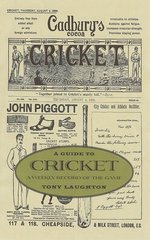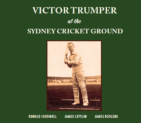A Guide to Cricket
Martin Chandler |Published: 2013
Pages: 154
Author: Laughton, Tony
Publisher: Christopher Saunders Publishing
Rating: 4.5 stars

Its title suggests that this book is a gentle introduction to our great game, possibly written with a view to being read by the young, or alternatively by potential enthusiasts in the Americas, or some other country where cricket has yet to take root. I hope however that nobody buys it on either of those assumptions, as if they do a sport that can be confusing to the unwary at the best of times, will baffle the uneducated completely.
Contrary to the expectations created by its title Tony Laughton’s book does not guide its reader through the laws of the game, nor the lives of famous players, or the course of historic matches. What Cricket means in this context is Cricket: A Weekly Record of the Game, a periodical that appeared in 33 volumes between 1882 and 1914.
Is the story of a magazine that disappeared from the newstands all but a century ago really an interesting read? I would have to concede that it is unlikely to be much competition, in terms of volume of sales, for Matt Prior’s forthcoming autobiography, or Gideon Haigh’s offering about this summer’s Ashes series, but for those of us who are interested in the literature of the game it is, I have to say, absolutely fascinating.
There are elements of a kitchen sink drama about the story. It would seem that, for a time – after it was launched by CW Alcock – best known for being the driving force behind the FA Cup – it was profitable. After his time at the helm, which included a falling out with his right hand man, publisher WR Wright, the mantle of responsibility fell, amongst others, on the comparatively well-known FS Ashley-Cooper, and then the rather less remembered JN Pentelow before, prior to the outbreak of the Great War effectively spelling the end, there was a last ditch attempt by Pentelow to launch a rebranded World of Cricket, in partnership with former England captain AC MacLaren.
Alcock seems to have been an astute man, and Wright also, but the others were less so, and anyone who has read Mike Down’s splendid biography of the original Archie Mac will know just what a feckless and unreliable businessman he could be, and his tenure at the helm of the magazine was entirely “in character”.
The first part of the book contains the story of the birth of Alcock’s brainchild, its subsequent establishment as what he intended it to be, and then the slow decline. That fall began with Alcock’s passing and accelerated through the Edwardian era before the death throes of The World of Cricket on the eve of the conflict that so badly mauled an entire generation. There are biographical details of all who were involved in the publication to any significant extent, which seem to be culled from a myriad of sources and which only those familiar with some of the more elusive writings of Irving Rosenwater are likely to have very much prior knowledge.
The second part of the book contains much detailed bibliographical information as well as a summary of the contents of each volume. I need to be a little careful here in what I say as much of The Wisden Collector’s Guide I reviewed last year is taken up with something similar, and I was rather critical of that. I think on reflection I may have been a little harsh on the Wisden volume, but there are some significant differences between the Almanack and Cricket: A Weekly Record of the Game. All of those distinctions arise out of the nature of the beast. Wisden is, in comparative terms, widely collected. There is a brisk trade in old editions and buyers know, or certainly should know, what they are getting. Cricket: A Weekly Record of the Game is not so widely prized, and its rather more ephemeral nature means that not all the supplements and other occasional additional items survive. For the completist the information here is crucial.
The reason for my somewhat rueful look back at my review of the Wisden guide is the realisation of selfishness. My set of the good book is hardly a perfect one, but with the help of modern facsimiles it is complete, so I derive little benefit from a brief synopsis of each edition. I do also collect Cricket: A Weekly Record of the Game, but there is no way to acquire a set of that other than by visiting specialist dealers or auction houses. The early volumes, most of which I have, are not too difficult to source, and are not hugely expensive, a sum of less than GBP200 being sufficient to secure good copies. But the later ones are very tricky to acquire, and prices do rise, the rarely seen World of Cricket requiring an investment of the greater part of GBP1,000.
Tony Laughton’s book arrived on my doorstep at around noon on a Saturday. By bedtime I had read it from cover to cover. Its specialist nature means that according to the way we have always used our rating system it cannot score more than 4 stars, so the fact that I am still going to give it 4.5 says all that needs to be said about how highly I rate it. As for Cricket: A Weekly Record of the Game itself I have always regarded that as a curious period piece, but will be setting out to read those copies I have with renewed enthusiasm, particularly as I now know that in the course of her assistance to him in researching the book the author’s wife read every single page of all 33 volumes – I do hope he appreciates what a remarkable lady he has there!
And finally to the practicalities. Copies of A Guide to Cricket can be obtained through the Publisher in a standard paperback edition (as illustrated) at GBP25 or a casebound, signed limited edition of 50 copies at GBP100. The content is the same in either case, a high quality and beautifully illustrated production in keeping with the standards Mr Saunders has set over the years.






Leave a comment